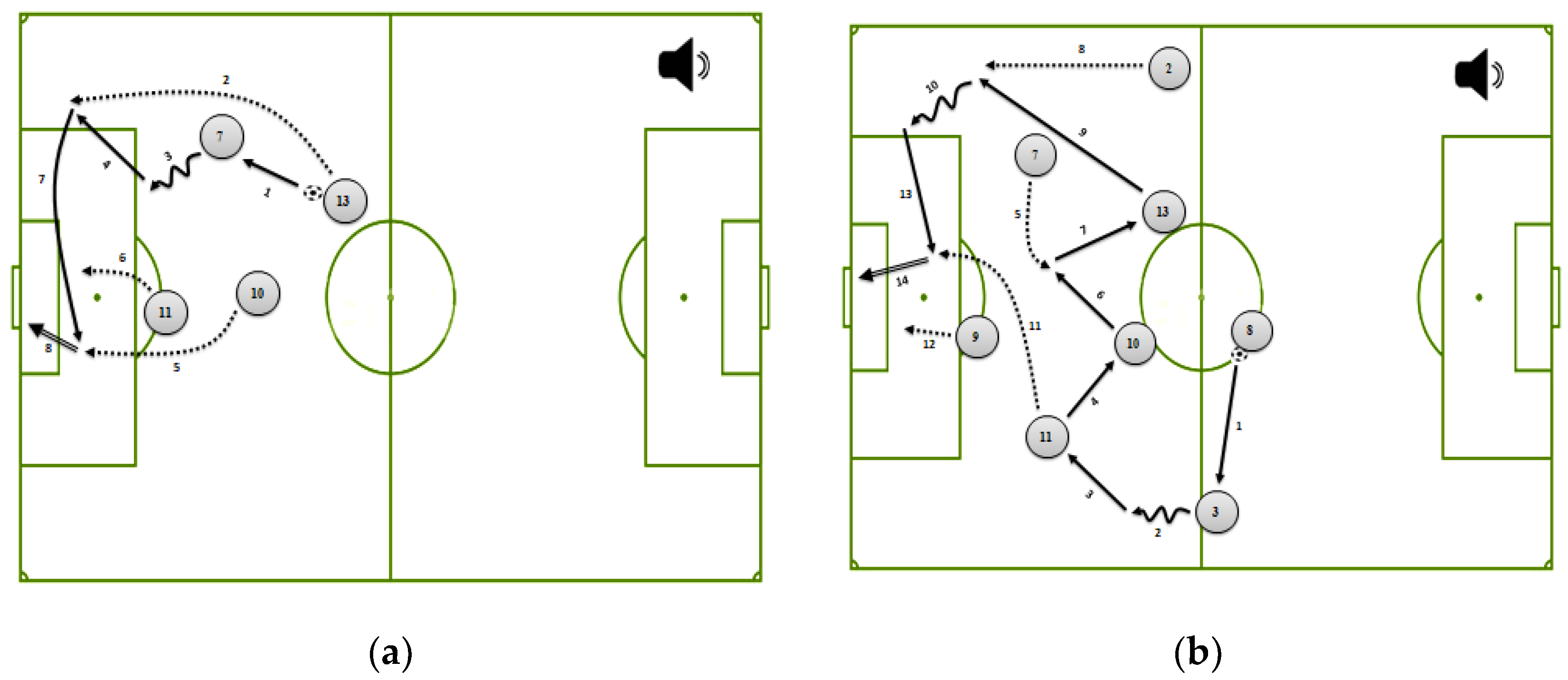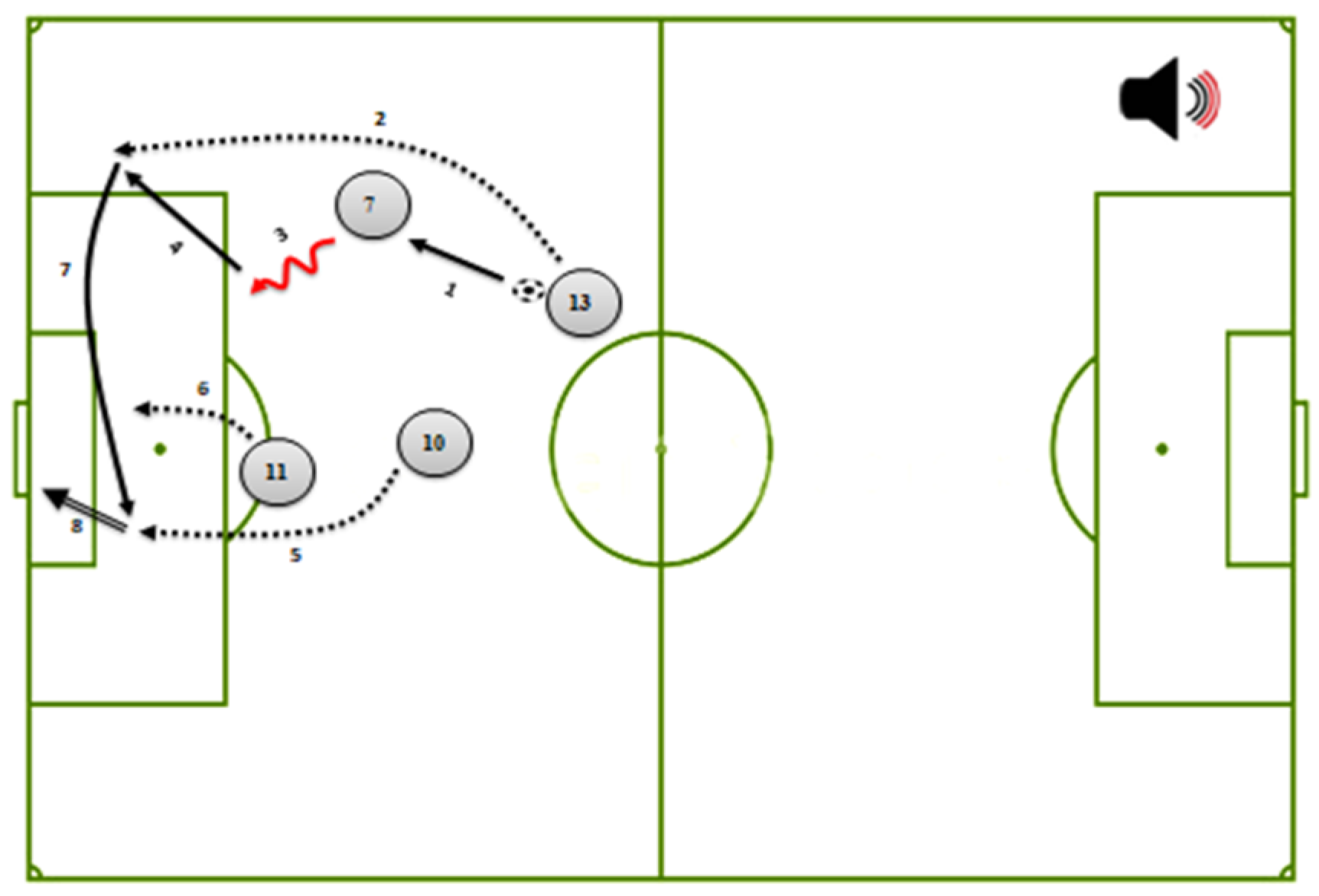Using Coordinated Visual and Verbal Cues in Complex Multimedia Materials to Improve Tactical Learning in Soccer
Abstract
:1. Introduction
2. Materials and Methods
2.1. Trial Design
2.2. Participants
2.3. Apparatus and Materials
2.3.1. Computerized Materials
2.3.2. Paper and Pencil Materials
2.4. Procedure
2.5. Statistical Analyses
3. Results
3.1. Recall Performances
3.2. Attitudes
4. Discussion
5. Conclusions
Author Contributions
Funding
Institutional Review Board Statement
Informed Consent Statement
Data Availability Statement
Acknowledgments
Conflicts of Interest
References
- Rekik, G.; Belkhir, Y.; Jarraya, M. Improving soccer knowledge from computerized game diagrams: Benefits of sequential instructional arrows. Percept. Mot. Ski. 2021, 128, 912–931. [Google Scholar] [CrossRef] [PubMed]
- Tversky, B. Visuospatial reasoning. In The Cambridge Handbook of Thinking and Reasoning, 1st ed.; Holyoak, K.J., Morrison, R.G., Eds.; Cambridge University Press: New York, NY, USA, 2005; Volume 209, pp. 209–240. [Google Scholar]
- Khacharem, A. Top-down and bottom-up guidance in comprehension of schematic football diagrams. J. Sport. Sci. 2017, 35, 1204–1210. [Google Scholar] [CrossRef]
- Tettamanti, M.; Buccino, G.; Saccuman, M.C.; Gallese, V.; Danna, M.; Scifo, P.; Fazio, F.; Rizzolatti, G.; Cappa, S.F.; Perani, D. Listening to action-related sentences activates fronto-parietal motor circuits. J. Cogn. Neurosci. 2005, 17, 273–281. [Google Scholar] [CrossRef] [PubMed]
- Mayer, R.E. Cognitive Theory of Multimedia Learning. In The Cambridge Handbook of Multimedia Learning, 1st ed.; Mayer, R.E., Ed.; Cambridge University Press: New York, NY, USA, 2005; pp. 31–48. [Google Scholar]
- Mayer, R.E. Multimedia Learning, 2nd ed.; Cambridge University Press: New York, NY, USA, 2009; pp. 3–27. [Google Scholar]
- Mayer, R.E. Cognitive Theory of Multimedia Learning. In The Cambridge Handbook of Multimedia Learning, 2nd ed.; Mayer, R.E., Ed.; Cambridge University Press: New York, NY, USA, 2014; pp. 43–71. [Google Scholar]
- Mousavi, S.Y.; Low, R.; Sweller, J. Reducing cognitive load by mixing auditory and visual presentation modes. J. Educ. Psychol. 1995, 87, 319. [Google Scholar] [CrossRef]
- Mayer, R.E.; Moreno, R. Aids to computer-based multimedia learning. Learn. Instr. 2002, 12, 107–119. [Google Scholar] [CrossRef] [Green Version]
- Fletcher, J.D.; Tobias, S. The multimedia principle. In The Cambridge Handbook of Multimedia Learning, 1st ed.; Mayer, R.E., Ed.; Cambridge University Press: New York, NY, USA, 2005; pp. 117–134. [Google Scholar]
- Brunken, R.; Plass, J.L.; Leutner, D. Direct measurement of cognitive load in multimedia learning. Educ. Psychol. 2003, 38, 53–61. [Google Scholar] [CrossRef]
- Brünken, R.; Leutner, D. Aufmerksamkeitsverteilung oder Aufmerksamkeitsfokussierung? Empirische Ergebnisse zur “Split-Attention-Hypothese” beim Lernen mit Multimedia. Unterrichtswissenschaft 2001, 29, 357–366. [Google Scholar]
- Brünken, R.; Steinbacher, S.; Schnotz, W.; Leutner, D. Mentale Modelle und Effekte der Präsentations und Abrufkodalität beim Lernen mit Multimedia. Z. Pädagog. Psychol. 2001, 15, 15–27. [Google Scholar] [CrossRef]
- Johnson, A.M.; Ozogul, G.; Reisslein, M. Supporting multimedia learning with visual signaling and animated pedagogical agent: Moderating effects of prior knowledge. J. Comput. Assist. Learn. 2015, 31, 97–115. [Google Scholar] [CrossRef]
- Richter, J.; Scheiter, K.; Eitel, A. Signaling text-picture relations in multimedia learning: A comprehensive meta-analysis. Educ. Res. Rev. 2016, 17, 19–36. [Google Scholar] [CrossRef]
- Mutlu-Bayraktar, D.; Cosgun, V.; Altan, T. Cognitive load in multimedia learning environments: A systematic review. Comput. Educ. 2019, 141, 103618. [Google Scholar] [CrossRef]
- Alpizar, D.; Adesope, O.O.; Wong, R.M. A meta-analysis of signaling principle in multimedia learning environments. Educ. Technol. Res. Dev. 2020, 68, 2095–2119. [Google Scholar] [CrossRef]
- Jamet, E.; Gavota, M.; Quaireau, C. Attention guiding in multimedia learning. Learn. Instr. 2008, 18, 135–145. [Google Scholar] [CrossRef]
- Ozcelik, E.; Arslan-Ari, I.; Cagiltay, K. Why does signaling enhance multimedia learning? Evidence from eye movements. Comput. Hum. Behav. 2010, 26, 110–117. [Google Scholar] [CrossRef]
- Mautone, P.D.; Mayer, R.E. Signaling as a cognitive guide in multimedia learning. J. Educ. Psychol. 2001, 93, 377. [Google Scholar] [CrossRef]
- Glaser, M.; Schwan, S. Explaining pictures: How verbal cues influence processing of pictorial learning material. J. Educ. Psychol. 2015, 107, 1006. [Google Scholar] [CrossRef]
- Xie, H.; Mayer, R.E.; Wang, F.; Zhou, Z. Coordinating visual and auditory cueing in multimedia learning. J. Educ. Psychol. 2019, 111, 235. [Google Scholar] [CrossRef]
- Faul, F.; Erdfelder, E.; Buchner, A.; Lang, A.G. Statistical power analyses using G* Power 3.1: Tests for correlation and regression analyses. Behav. Res. Methods 2009, 41, 1149–1160. [Google Scholar] [CrossRef] [Green Version]
- Rekik, G.; Belkhir, Y.; Jarraya, M. Searching to improve learning from complex animated basketball scenes: When decreasing the presentation speed is more efficient than using segmentation. Technol. Pedagog. Educ. 2021, 30, 393–407. [Google Scholar] [CrossRef]
- Smeeton, N.J.; Ward, P.; Williams, A.M. Do pattern recognition skills transfer across sports? A preliminary analysis. J. Sport. Sci. 2004, 22, 205–213. [Google Scholar] [CrossRef]
- Yang, H.Y. Effects of interactivity and progressive visuospatial cues on learners’ comprehension of dynamic visualizations. J. Res. Technol. Educ. 2021, 53, 178–205. [Google Scholar] [CrossRef]
- Schroeder, N.L.; Chin, J.; Craig, S.D. Learner control aids learning from instructional videos with a virtual human. Technol. Knowl. Learn. 2020, 25, 733–751. [Google Scholar] [CrossRef]
- Souissi, N.; Rekik, G.; Belkhir, Y.; Ezzeddine, G.; Hmida, C.; Kuo, C.D.; Chen, Y.S. Dynamic visual support is superior to its static counterpart in learning a series of Judo refereeing gestures. Int. J. Sport Exerc. Psychol. 2021, 1–14. [Google Scholar] [CrossRef]
- Chase, W.G.; Simon, H.A. Perception in chess. Cogn. Psychol. 1973, 4, 55–81. [Google Scholar] [CrossRef]
- Ekstrom, R.; French, J.; Harman, H.; Dermen, D. Manual for Kit of Factor-Referenced Cognitive Tests, 1st ed.; Educational Testing Service: Princeton, NJ, USA, 1976; pp. 147–172. [Google Scholar]
- Rekik, G.; Khacharem, A.; Belkhir, Y.; Bali, N.; Jarraya, M. The effect of visualization format and content complexity on acquisition of tactical actions in basketball. Learn. Motiv. 2019, 65, 10–19. [Google Scholar] [CrossRef]
- Rekik, G.; Belkhir, Y.; Mezghanni, N.; Jarraya, M.; Chen, Y.S.; Kuo, C.D. Learning Basketball Tactical Actions from Video Modeling and Static Pictures: When Gender Matters. Children 2021, 8, 1060. [Google Scholar] [CrossRef]
- Peterson, L.; Peterson, M.J. Short-term retention of individual verbal items. J. Exp. Psychol. 1959, 58, 193. [Google Scholar] [CrossRef]
- Hasler, B.S.; Kersten, B.; Sweller, J. Learner control, cognitive load and instructional animation. Appl. Cogn. Psychol. 2007, 21, 713–729. [Google Scholar] [CrossRef]
- Rekik, G.; Belkhir, Y.; Mnif, M.; Masmoudi, L.; Jarraya, M. Decreasing the presentation speed of animated soccer scenes does not always lead to better learning outcomes in young players. Int. J. Hum. Comput. Int. 2020, 36, 717–724. [Google Scholar] [CrossRef]
- Schwan, S.; Riempp, R. The cognitive benefits of interactive videos: Learning to tie nautical knots. Learn. Instr. 2004, 14, 293–305. [Google Scholar] [CrossRef]
- Jarraya, M.; Rekik, G.; Belkhir, Y.; Chtourou, H.; Nikolaidis, P.T.; Rosemann, T.; Knechtle, B. Which presentation speed is better for learning basketball tactical actions through video modeling examples? The influence of content complexity. Front. Psychol. 2019, 10, 2356. [Google Scholar] [CrossRef] [PubMed]
- Rekik, G.; Belkhir, Y.; Jarraya, M.; Bouzid, M.A.; Chen, Y.S.; Kuo, C.D. Uncovering the Role of Different Instructional Designs When Learning Tactical Scenes of Play through Dynamic Visualizations: A Systematic Review. Int. J. Environ. Res. Public Health 2021, 18, 256. [Google Scholar] [CrossRef] [PubMed]
- Glaser, M.; Schwan, S. Combining verbal and visual cueing: Fostering learning pictorial content by coordinating verbal explanations with different types of visual cueing. Instr. Sci. 2020, 48, 159–182. [Google Scholar] [CrossRef]
- Stevenson, R.A.; Altieri, N.A.; Kim, S.; Pisoni, D.B.; James, T.W. Neural processing of asynchronous audiovisual speech perception. Neuroimage 2010, 49, 3308–3318. [Google Scholar] [CrossRef] [Green Version]
- Su, Y.H. Content congruency and its interplay with temporal synchrony modulate integration between rhythmic audiovisual streams. Front. Integr. Neurosci. 2014, 8, 92. [Google Scholar] [CrossRef] [Green Version]
- Kalyuga, S. Expertise reversal effect and its implications for learner-tailored instruction. Educ. Psychol. Rev. 2007, 19, 509–539. [Google Scholar] [CrossRef]
- Richter, J.; Scheiter, K. Studying the expertise reversal of the multimedia signaling effect at a process level: Evidence from eye tracking. Instr. Sci. 2019, 47, 627–658. [Google Scholar] [CrossRef]



| Keywords | Arrow Symbols |
|---|---|
| Shot |  |
| Dribble |  |
| Pass |  |
| Move |  |
| Measurement Items | No Cues | with Cues | ||
|---|---|---|---|---|
| Simple | Complex | Simple | Complex | |
| Immediate recall performances | 2.65 (1.81) | 3.3 (2.79) | 3.25 (2.55) | 5 (3.61) * |
| Delayed recall performances | 2.35 (1.73) | 2.6 (1.85) | 3.45 (2.54) | 4.95 (3.43) * |
| Measurement Items | Component (Factor Loading) Attitudes | Cronbach’s Alpha Coefficient (α) |
|---|---|---|
| Enjoyment | 0.906 | 0.745 |
| Attention | 0.497 | |
| Motivation | 0.867 | |
| Interestingness | 0.690 | |
| Self-efficacy | 0.518 | |
| Eigen value | 2.562 | |
| Variance% | 51.230 | |
| Cumulative% | 51.230 |
| Measurement Items | No Cues | with Cues | ||
|---|---|---|---|---|
| Simple | Complex | Simple | Complex | |
| Overall attitudes | 6.97 (1.25) | 6.4 (1.62) | 6.71 (1.3) | 7 (1.45) |
| Enjoyment | 7.05 (1.85) | 6.1 (2.31) | 7.3 (1.59) | 7.5 (2.12) |
| Attention | 6.95 (1.64) | 7.1 (1.59) | 6.55 (2.11) | 8.1 (1.25) |
| Motivation | 6.9 (2.25) | 6 (2.45) | 6.9 (2.2) | 7 (2.2) |
| Interestingness | 7.1 (1.62) | 7.2 (2.31) | 6.6 (2.23) | 6.95 (2.14) |
| Self-efficacy | 6.85 (1.57) | 5.6 (1.54) | 6.5 (2.01) | 5.75 (2.02) |
Publisher’s Note: MDPI stays neutral with regard to jurisdictional claims in published maps and institutional affiliations. |
© 2022 by the authors. Licensee MDPI, Basel, Switzerland. This article is an open access article distributed under the terms and conditions of the Creative Commons Attribution (CC BY) license (https://creativecommons.org/licenses/by/4.0/).
Share and Cite
Mezghanni, N.; Rekik, G.; Crowley-McHattan, Z.J.; Belkhir, Y.; Ayed, R.B.; Hadadi, A.; Alzahrani, T.M.; Kuo, C.-D.; Chen, Y.-S. Using Coordinated Visual and Verbal Cues in Complex Multimedia Materials to Improve Tactical Learning in Soccer. Int. J. Environ. Res. Public Health 2022, 19, 3365. https://doi.org/10.3390/ijerph19063365
Mezghanni N, Rekik G, Crowley-McHattan ZJ, Belkhir Y, Ayed RB, Hadadi A, Alzahrani TM, Kuo C-D, Chen Y-S. Using Coordinated Visual and Verbal Cues in Complex Multimedia Materials to Improve Tactical Learning in Soccer. International Journal of Environmental Research and Public Health. 2022; 19(6):3365. https://doi.org/10.3390/ijerph19063365
Chicago/Turabian StyleMezghanni, Nourhen, Ghazi Rekik, Zachary J. Crowley-McHattan, Yosra Belkhir, Rayda Ben Ayed, Atyh Hadadi, Turki Mohsen Alzahrani, Cheng-Deng Kuo, and Yung-Sheng Chen. 2022. "Using Coordinated Visual and Verbal Cues in Complex Multimedia Materials to Improve Tactical Learning in Soccer" International Journal of Environmental Research and Public Health 19, no. 6: 3365. https://doi.org/10.3390/ijerph19063365









